In late October, Cluely founder Roy Lee made headlines at TechCrunch Disrupt 2025 after telling a crowd that startups and emerging tech “have to be extreme” in order to stand out. This statement came only months after Cluely claimed that the AI assistant app could help you “cheat on everything” — a claim that immediately went viral and was also confirmed by Cluely to be a purposeful marketing tool used to bait consumers.
From Sam Altman’s controversial statements surrounding AI to Elon Musk’s plethora of tweets that have been scrutinized for spreading disinformation, “rage bait” marketing strategies seem to be the new norm for several startups and their founders.
Yet, recent data begs the question: how far can controversial marketing tactics go in an industry that is already controversial in nature? A June study by Deloitte found that 82% of the surveyed gen AI users said that the technology can be and is misused, while 24% reported privacy issues. Focaldata’s recent report found that half of its 900 participants believe internet-related tech has had the most negative impact in the world, citing the dark web, social media, and AI.
So, does “rage-baiting” consumers truly work when all they desire are accessible, safe tech solutions that provide long-term value? Ultimately, technology startups can penetrate saturated markets using tried and true tactics that mirror what consumers want — reliable, ethical technology.
Startup Strategies: Finding Your Voice and Telling Your Story
Massive competition is unavoidable in the tech world. Startups must know their product differentiators and create avenues to tell their story in an impactful and digestible way, which is why having several marketing strategies in your tool belt is key to success.
Thought Leadership
With so many voices in the industry, brands must come ready with subject matter experts eager to provide cutting-edge expertise and opinions. To establish thought leadership, founders can leverage:
- Bylines: Expert-written bylines with thought-provoking opinions and data on trending topics should be a priority. With the right media on hand and purposeful pitching efforts, you can cement your experts as industry leaders.
- Podcasts: The growing popularity of podcasts has created another great thought leadership option. With an endless number of shows that could fit your niche, podcasts are a more personable and palatable avenue for showcasing your experts.
- Whitepapers: Perfect for attracting investors and potential clients, whitepapers build credibility and provide solutions to problems. Not to mention, whitepapers can be used throughout the lifetime of your startup, from the early days when showing investors how your tech will compete with existing brands to studies on growing trends and how your solutions will address them.
- Speaking engagements: Show your clients, investors, and the market that you are ready to face the industry head-on and are available to answer their questions in real time.
Storytelling
Personalized and emotionally driven, storytelling marketing tactics underscore the human connection between your product and consumers.
- Staff profiles: Ideal for social media content calendars and email marketing campaigns, these profiles emphasize how important your brand’s team is to the success of your product.
- Case studies: Potential customers not only need case studies to see exactly how your product has worked, but to find first-hand client testimonials.
- Newsletters: Owned newsletters allow startups to create an educational hub for their brand, including narrative-style bylines, staff profiles, and trend pieces, just to name a few.
- Video: From how-to videos to inspirational ads to organic & creative content that jumps on recent trends, video tends to be the most engaged with content across the board and leaves less “work” for the consumer to digest the content.
- Infographics: Need a way to condense your data in an easy-to-read manner? Infographics are eye-catching and allow readers to understand the facts quickly. Infographics are also a great way to generate interactive content.
Digital Presence
It is not uncommon for tech startups to fly under the radar. The competition is always watching, and poaching is more problematic than ever. That said, you need an online presence now more than ever — consumers and investors are wary, and they will Google you.
- Website: Your site is the core of your online identity. It must move past vague claims and explain the problem you solve, the outcomes you deliver, and what makes your approach different. Clean design, engaging visuals, and clear navigation help visitors understand your value quickly.
- Social media: You do not need to be everywhere, but you do need to be present. Focus on platforms where your audience is already active. Consistent updates, founder insights, product snapshots, and behind-the-scenes content build a connected community. Focus on quality over quantity.
- User-generated content: Authentic proof from early users carries weight and eases the burden for internal content teams. Testimonials, real-world demos, and organic mentions help potential buyers understand how your solution fits into their lives and reduce the need to produce every asset in-house.
Bottom Line: Intent Matters
No matter your specific solution, service, or product, consumers are good at pinpointing why it matters to them and how seriously you take your brand. Before ever executing a campaign, you need an intentional strategy.
ARTÉMIA Communications helps emerging tech companies cut through the noise without relying on shock value or manufactured controversy. We focus on strong positioning, credible messaging, and proven tactics that hold up under scrutiny. If you want a partner that can elevate your story and strengthen your presence in a way that lasts, get in touch.





